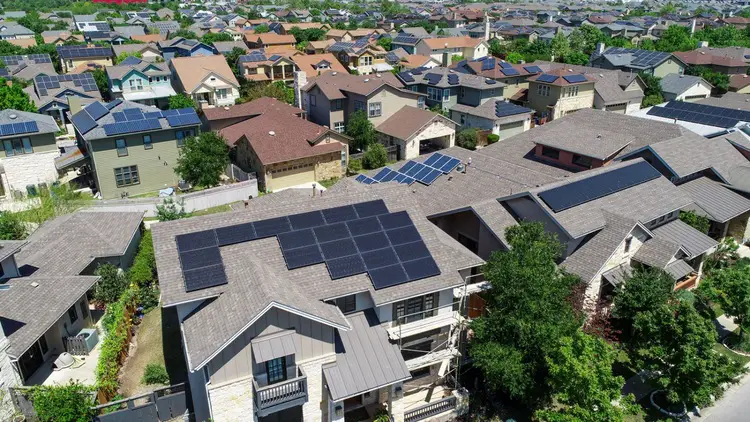Ten years ago, seeing solar panels on homes was a relatively rare occurrence. We’ve been installing solar since 2016, so we’ve always kept an eye out for other systems. Driving to and from our job sites, I was always surprised at how little solar I saw. Fast forward to today, its virtually impossible to go outside and not see solar (and not just because I have panels on my roof now).
According to Solar Energy Industries Association, over 6.8 GW of solar was put on homes in the United States last year, breaking the previous record set in 2022. To offer a rough translation, that is approximately 680,000 homes (assuming an average system size of 10 kW, which is fairly standard) in one year. This trend isn’t expected to slow down anytime soon. The graph below (courtesy of Wood McKenzie’s US Solar Market Executive Summary) illustrates an average annual growth rate of 10% until 2028 (accounting for a slight dip in 2024).
Okay, so solar is growing in the United States. Why are so many people converting to solar? Well, most people (probably 99.99%) go solar for the economic benefit, specifically lowering their energy costs. However, it’s not the right choice for everyone. Pushy solar companies might tell you that everyone should have solar, but that’s just not necessarily the case. Let’s break down the formula for whether or not it makes sense for you and your home.
Calculation 1: Your Current Situation
Right now, you get power from your meter (connected to your local electrical grid), normally on the side of your house. Your meter was installed by an electric company (in our area, this includes SMECO, PEPCO, BGE, and Potomac Edison). The reason you recognize your utility’s name is because they send you a bill every month. The cost of that bill is based on how much electricity you use that month, measured in kWh, a unit of electricity. An average cost for a kWh is around 15.5 cents. So, if you use 1,000 kWh a month, your bill would be $155, plus a small flat fee. Naturally, the more power you use, the higher the bill.
Calculation 2: The Proposed Solution
What solar installers do is recommend you get your electricity from somewhere else. Don’t buy it from the electricity company but instead, produce your own. If you can get solar to make a kWh for cheaper than you can buy it from the utility, then it makes sense to go solar. The next question is, how can you determine the cost to make the kWh you need with solar? To figure that out, you need to determine a few things. The first is the net cost of the system. There are many incentives for going solar which lowers the “sticker price”. For example, a solar system that costs $35,000 will only cost you $17,540 “out the door” after incentives such as the below:
- $1,000 – Maryland Rebate
- $10,500 – 30% Federal Tax Credit
- $5,960 – Energy Credits
You’ll have to discuss with the solar company what your exact incentives are, but it should be fairly straightforward after the design is finalized. The next thing you’ll want to know is how many kWh’s the system will produce over its lifetime. Again, the solar company should be able to give you that information. For example, an 8.88 kW system could produce 238,464 kWh in its lifetime. It’s important to trust the company, as some companies have given rather optimistic figures, so make sure to do your research! Secondly, ensure the equipment is up to par and has product warranties that last at least 25 or 30 years.
Calculation 3: Putting It All Together
The last step is to determine the cost per kWh. To do that, all you have to do is divide the net cost by the lifetime output of the system. Let’s look at an example, using the figures from above:
So, in the simplest terms, every kWh your system produces will cost 7.36 cents. Now, compare that new cost to the current cost that you pay with your utility (see Calculation 1). In this case, it does make sense, since 7.36 cents is less than half of 15.5 cents!
Some Things to Remember
- Beware those misleading companies: As mentioned above, some companies exaggerate how much power the system will produce over its lifetime so ensure the numbers make sense. A nice shortcut is to see the system’s production ratio (Year 1 Production divided by the System Size in kW). For example, in Maryland, look for a production ratio of 1.1 – 1.35.
- Look at your bill: Take a look at this month’s bill. To find your “rough” price per kWh, take the total cost divided by your monthly usage in kWh. To be extra accurate, don’t include any flat fees.
- Consider the future: You might have noticed that your electric bill is getting higher each year. You’re not alone! Due to the increasing scarcity of nonrenewable resources, the rising cost of money, and the cost needed to maintain the current electrical infrastructure, the cost for a kWh from the electric company will continue to increase. In the last 20 years, the average cost for residential utility rates has increased by 3.8% each year! Switching to solar locks in that new rate.
- Let us do the hard work: Did this article pique your interest? Let us do the heavy lifting and show you your personalized numbers for your home. Its completely free- all we need is your bill and we can create a proposal with all the numbers!


